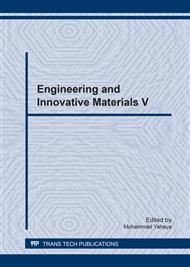p.178
p.184
p.191
p.195
p.201
p.209
p.215
p.221
p.229
The Influence of Temperature on Conductivity and Dielectric Properties of PMA/PVAc Blend with Addition of TPAI Salt
Abstract:
Ionic conductivity for polymethyl acrylate (PMA) and polyvinyl acetate (PVAc) blend at composition 90:10 in the presence of tetrapropyl ammoinum iodide (TPAI) showed linear increment with temperature. At selected frequencies, the values for both dielectric constant, εr and dielectric loss, εi are found to increase with temperature. It is also found that the variation of εr is in agreement with conductivity variation of PMA/PVAc-TPAI samples. The imaginary part of electric modulus,Mi showed the occurance of dispersion peak. Relaxation time of ionic charge carrier are extracted from the Mi maximum peak at various temperatures. It is found that relaxation time decreased with increasing temperature from ~10-4 s at 343 K to ~10-5 s at 373 K.
Info:
Periodical:
Pages:
201-206
Citation:
Online since:
March 2017
Authors:
Keywords:
Price:
Сopyright:
© 2017 Trans Tech Publications Ltd. All Rights Reserved
Share:
Citation:


